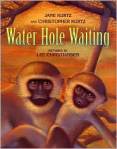- by Jane Kurtz and Christopher Kurtz
- Illustrated by Lee Christiansen
- Publisher and date: Harper Collins, March 2002
- Genres: fiction
- Age/Grade:ages 4-8
Author’s perspective: (from Jane’s website)
Jane Kurtz was born in Portland, Oregon, but when she was two years old, her parents moved to Ethiopia. Jane grew up in Maji, a small town in the southwest corner of the country. Since there were no televisions, radios, or movies, her memories are of climbing mountains, wading in rivers by the waterfalls, listening to stories, and making up her own stories, which she and her sisters acted out for days at a time. When she was in fourth grade, she went to boarding school in Addis Ababa. Her family left Ethiopia in the late 1970s, but a decade later, first her brother and his family and then her older sister and her family went back to teach in a girls’ school in Addis Ababa. By the time Jane came back to the United States for college, she felt there was no way to talk about her childhood home to people here. It took nearly twenty years to finally find a way – through her children’s books. Now she often speaks in schools and at conferences, sharing memories from her own childhood and bringing in things for the children to touch and taste and see and smell and hear from Ethiopia. “It’s been a healing and inspiring experience,” she says, “to re-connect with my childhood and also be able to help people know just a little of the beautiful country where I grew up.”
Literary Elements:
Setting – (from the author’s note) “Although this story is fiction, it is possible to learn many things about lie on the African savanna from it. Anyone who has sat and watched a water hole for awhile notcies that the animals seem to take turns. Sometimes, especially during this dry time, different speciies will drink at a water hole together.”
Style/tone – The book has almost a poetic feel to it because of the great vocabulary (slip, slap, lip lap; splish, splush, slurp, slush).
Organization- Informative author’s note at the end provides lots of background info on the water hole and the animals that use it.
Curriculum Connections:
-
From Jane‘s website: Read the book’s text (before sharing Lee Christiansen’s illustrations) and ask students to choose a scene they would like to illustrate. Compare the children’s illustrations to the images created by the illustrator.
- Information about water holes (from Jane’s website) – http://www.janekurtz.com/books/aboutwaterholes.html
- Africam.com – http://www.africam.com – Watch African wildlife on the internet
- Compare with the book African Animals, by Caroline Arnold
- Vocabulary – Great sound words are used in this book, as well as interesting moving words. Create a chart with all the wonderful words.
Web Resources:
Review:
From Kirkus Review (from: www.bn.com)
A baby monkey awakens on the African savanna, eager for a trip to the watering hole. But Mama makes him wait as they watch a parade of animals take turns drinking. His cautious mother must physically restrain him with a pull on the tail or a grab at his neck to keep him from being eaten or trampled by the other animals. Some awkward phrasing: “The silence pokes at Monkey’s ear,” is balanced by internal rhyme that works well for read-aloud: “Sun cartwheels slowly up the sky, herding hippopotami. The grasslands fill with birdcalls, wails, a loud buzz-buzzing of insects, a great swish-swishing of tails.” Soft-focus pastels convey the golden light and heat of the savanna. Close-ups of the creatures are sure to appeal to animal enthusiasts, although the monkeys, especially Mama, look depressed or angry. An author’s note explains watering-hole protocol and the signaling system of the vervet monkeys portrayed in the story. (Picture book. 4-8 )
